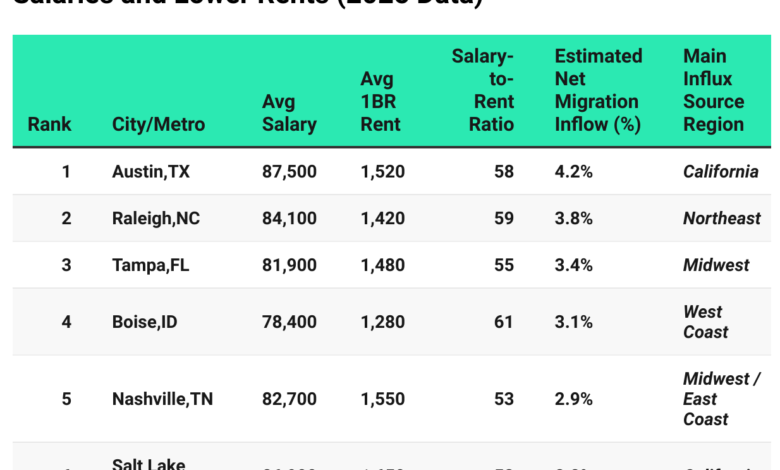Where Americans Are Moving for Higher Salaries and Lower Rents (2025 Update)

Key Takeaways
- Americans are prioritizing value over prestige — choosing metros where income buys more space and stability.
- Remote work is flattening the salary map, letting professionals earn coastal wages from inland cities.
- The salary-to-rent ratio is the new benchmark for economic mobility in 2025.
As the cost of living in America’s largest metro areas continues to soar, more workers are relocating to cities where their salaries stretch further. According to 2025 migration and housing data, Americans are leaving high-cost coastal metros like San Francisco, Los Angeles, and New York for affordable, fast-growing cities offering strong pay and lower rents.
The rise of remote and hybrid work has made it easier than ever to earn a big-city salary while enjoying a lower cost of living elsewhere. Let’s look at the U.S. cities where Americans are moving in search of higher wages and cheaper housing.
Why Americans Are Moving?
The key driver isn’t just housing affordability — it’s the salary-to-rent ratio. In many smaller metros, workers earn nearly the same as peers in coastal hubs but pay half as much for housing.
- Remote work freedom: More than 25% of white-collar employees now work remotely at least part-time.
- Tax advantages: States like Texas, Tennessee, and Florida attract professionals with no state income tax.
- Lifestyle & affordability: Cities like Raleigh, Boise, and Greenville offer safer neighborhoods, newer housing, and shorter commutes — while keeping living costs reasonable.
Where People Are Leaving?
According to the IRS migration database and Zillow rental reports, the largest outflows in 2025 came from:
- San Francisco, CA (median rent $3,300; avg salary $108K)
- Los Angeles, CA (median rent $2,700; avg salary $95K)
- New York, NY (median rent $3,100; avg salary $104K)
- Seattle, WA and Boston, MA, both of which saw net domestic migration losses despite strong job markets.
How to Identify “High Salary, Low Rent” Cities
When comparing cities, two numbers matter most:
- Median income or average salary
- Median rent or mortgage payment
Divide salary by annual rent to calculate the Salary-to-Rent Ratio — the higher, the better.
For example:
- Austin: $87,500 ÷ ($1,520 × 12) = 4.8× annual rent
- San Francisco: $108,000 ÷ ($3,300 × 12) = 2.7× annual rent
That means the typical Austin professional keeps nearly twice as much of their paycheck for savings or investments.




